|
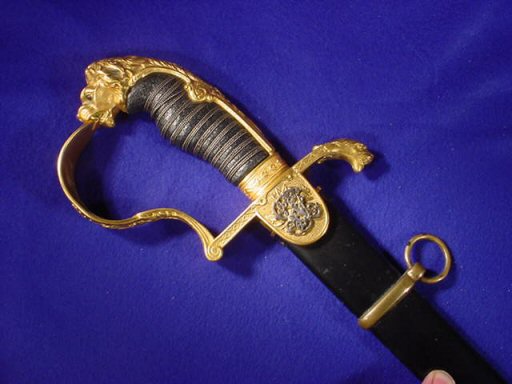
|
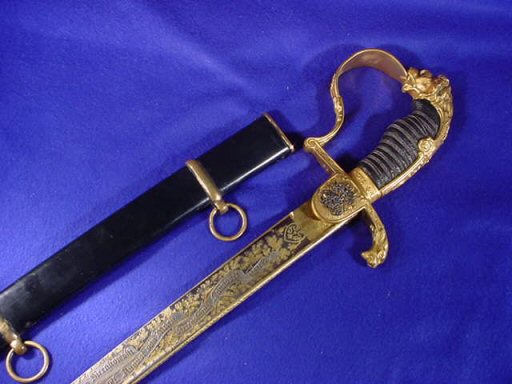
|
|

|
|
Massive Prussian Officer’s Saber in Damascus Steel (Item ANTWEP 2-2; KWEPS 4-2)
|
| DESCRIPTION: This is one of the most magnificent imperial swords we have ever seen in any collection and even most German museums do not number a sword this fine in their inventory. This is one very massive sword with true Damascus blade and wonderful, highly engraved décor. It is naturally a presentation from one Prussian noble to another. The “s/l” you see on the blade stands for “Seinen Leben,” or “…to my dear friend…” Both men are ‘vons,’ the attachment of Germanic nobility. The sword was presented in fond memory of their time spent as comrades in the Kriegsschule (War Academy) in the city of Hannover from 1895 to 1895. The sword is elegant plus. Its blade is such that it must have been a very expensive item in its day. Running ones fingers over the relief letters and floral design one realizes the sharpness of supreme quality that attends this sword. You might just agree that here is an exceptional weapon that is as good as they could ever be and then some! This massive sword is 41 inches long in its scabbard. The blade at the thickest point is about 1 3/4 inches wide. The blade is 34 inches long. The languet as continuation of the ‘D’ guard is decorated with a lettered overlay in silver that is very intricate and involved, but probably works out to initials of the recipient. The eyes in the lion-head pommel are either rubies or garnets. The back languet has an engraved crest and this is possibly the crest of the fortunate recipient. Because the languet covers that portion of the blade it is difficult to see it. There is a maker’s logo or signature and we believe there are none. However, the quality of the sword screams ‘W.K.C.” (Weyersberg, Kirshbaum, & Co.). Here is the finest type of Damascus steel employed as well in the beautiful tree-bark pattern. For condition overall this piece would rate as excellent double plus. The leather on the grip wrapped with silver wire is in excellent shape. A collector would be hard pressed to ever find a sword as fine as this one. We have attended the German Waffenborse (arms shows) for many years now and never have seen one as good as this ever offered. This is surely the epitome of Deutscher Säbel.
PRICE: SOLD |
Indian Pipe Tomahawk (Item ANTWEP 2-4; AMINDIAN 1-7) |
DESCRIPTION: Here is a classic pipe tomahawk of the type that was traded to the Indians of practically all the nations from the east coast to the far western plains. The axe heads were produced in iron shops back east but the haft that was generally decorated with driven brass tacks were generally produced by the tribesmen themselves. The tomahawk haft with head measures 21 inches. The head measures 6- 3/4ths from cutting edge to pipe bowl. The inclusion of the pipe bowl on the weapon was a brilliant idea on the part of the white traders who learned how much spiritual value that the Red Men attributed to tobacco and their love of weaponry was also taken into consideration as well. So these axe heads were a great combination piece that would be highly prized by the tribes. We do not know what culture group this example comes from because the mounting was pretty much the same whether Souix, Crow, Comanche or Cherokee. This example is a very fine specimen with the traditional berry staining on parts of the haft. It has many brass tacks applied. The shaft is drilled though to facilitate smoking, but often as not they were never smoked and for the greatest part never even carried but they would be quickly brought from the tepee or lodge if a photographer was nearby. Then it would be an important part of the regalia of the proud warrior as he posed for photo shots by men such as Mathew Brady. These ‘Hawks’ were of great importance to the proud braves who bore them and extremely rare to find today.
A great museum quality example of historical importance to the preservation of the art and customs of the Native Americans.
PRICE: SOLD |
|
|
|
|
|
|
 |
|
|
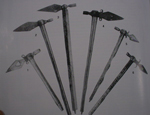 Types of spontoons
Types of spontoons |
|
| Picture from book
Plains Indian Spontoon Pipe Tomahawk (Item ANTWEP 2-6; AMINDIAN 1-11; USARTICLES 2-22) |
DESCRIPTION: Here is what I would consider the rarest of the rare. A genuine Spontoon Tomahawk. As we have said in an earlier article on this page these ‘hawks” were traded to the Indians of many tribal groups but this type was pretty much traded and used by the tribes of the Western Plains. This one has a stamp on its lade that says U.S. Government and this opens up several possibilities. Could the piece be one of numerous items presented to certain tribal members who served in or as scouts for the army? Or could the heads have been fashioned from other Government owned items such as rifle barrels? Although the metal heads were produced in the East, the wooden shaft was generally handmade by the warriors themselves and of course the brass tacks were invariably used as decoration. The blade of this magnificent specimen measures a huge 11 inches across from the pipe bowl to the lethal tip. The haft measures with head or blade 23 ½ inches long. The portion just below the head and also at the bottom-most section is wrapped with old sinew. This was typical for the nations of the Sioux and Cheyenne
We explained in another article the reason for the inclusion of a pipe bowl in these weapons. It had to do with the spiritual values of the red men. This shaft is done in the traditional manner with berry staining that shows age and of course the shaft is drilled through to allow the pipe to be ceremoniously smoked. The drilling with limited tools was a painstaking project in those days of yore. “An extremely difficult task”. Many examples have been found that were never drilled but this one is in fact drilled through and as we have earlier recounted above in USARTICLES 1-7 these tomahawks were mostly used for show. The hawks similar to the one shown in USARTICLES 1-7 do occasionally show up but a huge spontoon model like this is extremely rare. This is the finest example that we have ever seen in many years of hunting the finest of Indian relics. Look no farther if you are hoping to gain a real museum piece personified.
PRICE: SOLD
|

|
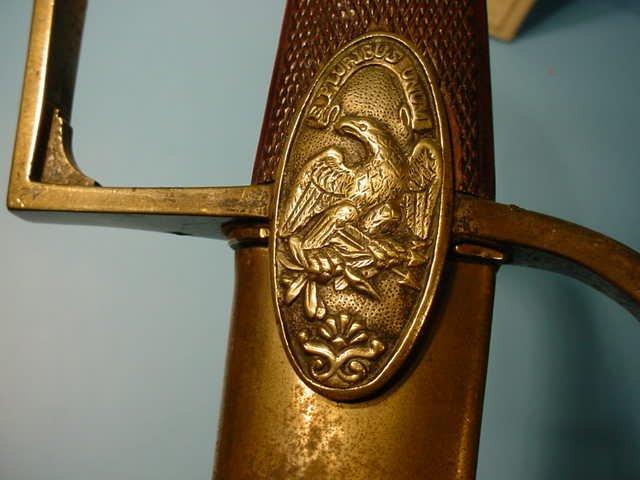
|
|
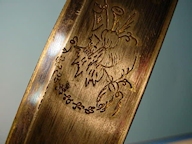
|
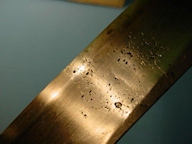
The museum-repaired break
|

|
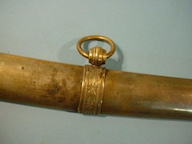
|
|
Period Sabre (Mounted Infantry Officer) from the War of 1812 (Item ANTWEP 2-7; USARTICLES 2-25)
|
|
DESCRIPTION: This is an eagle-head sabre of the Standish Barry variety. It was probably made in France or, possibly, Solingen, Germany. This sword is large, almost 40 inches in length with a blade measuring about 33 inches long. This is a beautiful example of a sword pretty enough for dress occasions, but made for combat as well. In fact, we feel strongly that this one was used in the War of 1812. Some circumstantial evidence of this can be extrapolated from the fact that the sword was broken at one time and a repair was effectuated about 9 inches up from the tip. The repair was well done; probably by a blacksmith or, possibly, by a jeweler. In any case, the sword was brought back to fighting efficiency. Was this done at the behest of the original owner or by a museum lucky enough to have received both blade parts? This early damage gives thought to how it was broken could it have been injured in a combat situation with the American trooper bringing it down with force against the helmet of one of the invading British invaders? Well, let’s hope that in that case it was not only the blade that was broken (Ouch!) The checkered grip is of hickory wood and is in remarkable condition after some 200 years. The eagle’s head of the Standish Barry style is a more noble-looking predator than the usual one of the period. The languet that is seen on the crossguard is a beautiful artist’s perception of the American national eagle that is perched on laurel leaves of peace while holding the arrows of war. Over this can be seen the words in Latin E PLURIBUS UNUM (Out of many, one).
"E Pluribus Unum" was the motto proposed for the first Great Seal of the United States by John Adams, Benjamin Franklin, and Thomas Jefferson in 1776. This eagle and motto serve to make this great sword a prodigiously important relic of American’s war of 1812 against British tyranny, and later we remember the courageous struggle of the Confederate states against Lincoln; these were the wars of national defense. We won the 1812 struggle, but real America lost the so-called “Civil War.” There, our nation lost its innocence and began its long road to becoming a tyrannical power in itself. “Here we go again!" So much for revisionist history for today.
This is a great sword for any museum or prestigious private weapons collection.
PRICE: SOLD
|
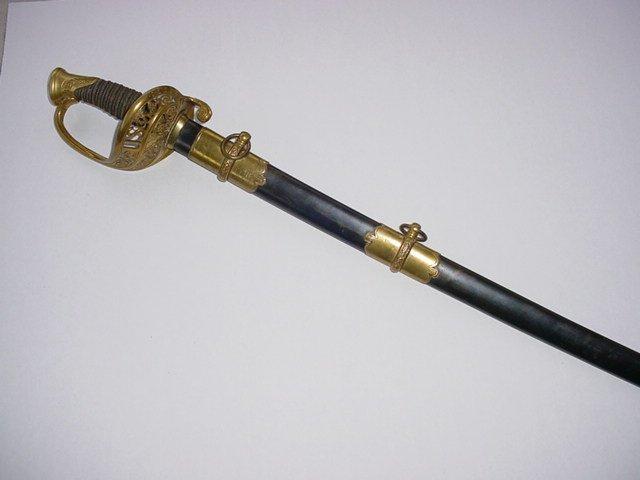
|

Captain J. T. Lurvey
|
|
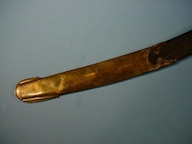
|
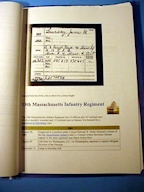
Some papers
|
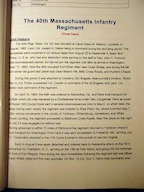
|
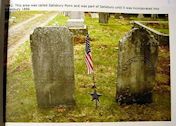
The captain's grave
|
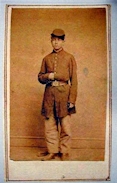
The captain's son
|
|
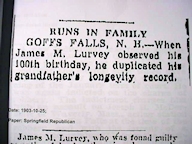
Copies of newspaper clippings
|
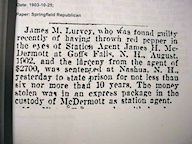
|
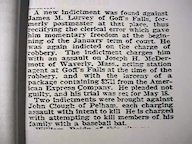
|

|
|
Superb Ames Mod 1850 Staff and Field Sword with Presentation and Vastly Interesting Provenance (Item ANTWEP 2-26; USARTICLES 2-28)
|
|
DESCRIPTION: This beautiful M1850 commercial model staff- and field-officer’s sword has the early etched mark of the Ames Company on the blade and is correctly stamped on its scabbard. It is the early type transition sword as shown in John Thillmann’s book Civil War Army Swords. The sword was awarded to Captain J.T. Lurvey of company ‘A’ 40th Massachusetts Volunteers by the citizens of Saugas, Massachusetts in August 1862. Then what is remarkable is that Lurvey in 1904 awarded the sword to his grandson Edwin M. Chamberlin. Both of these engraved presentations are properly recorded in the finest of engraved legends on the sword’s scabbard with the times of their occurrence. Accompanying the sword are 27 pages of official military records of his unit’s service in the Civil War otherwise known here In Georgia as the War of Yankee Aggression or the Second War of Independence fought in our land. These are accompanied with copies of newspaper clippings and judicial articles and decisions concerning J. T. Lurvey and his wife’s alleged criminal activities after the war that unfortunately was won by the wrong side! His grandson enlisted as an army musician when he was 15 years old in 1862. He was mustered into ‘A’ company Mass. 40th Infantry in 1864. He was a musician in the 4th Heavy Artillery Co. There is a great biography of James Thomas McDonough Lurvey and his transition from second lieutenant to captain in the Mass. Infantry. His prewar occupation was as a shoemaker. Interesting, however, is the fact that one military record shows him as being a dentist. His wife Rossilla Judkins Lurvey whom he wed in 1845 died in 1873 doubtless from an incident in which both Lurvey and wife were thrown from a wagon (clipping included) around 1878. James remarried a younger lady by the name of Cynthia Jewett. One child was born of each of the marriages. From his first marriage to Rossilla was born James M. Lurvey and to his second a daughter named Florence. James T. Lurvey died in 1904 and a photo of his gravestone is included. James’ life was not without controversy. The papers include a court case where he purportedly purloined millinery involving his wife Rossilla, but that is the only whiff of controversy we found regarding the good captain. His son, James M. Lurvey, who also fought, led an even more interesting and much, much longer life. Young James entered service at age 15 (or more likely 14) as a drummer boy in July 1862 with Co. A 40th Massachusetts Infantry, the very unit in which his father was commissioned a captain the next month. In July 1863, he was transferred into Company B Veteran Reserve Corps. 13th Inf. He was discharged the following October. He joined up again in August 1864; this time with Co. H, 4th Mass. Heavy Artillery from which he was mustered out in June 1865 in Washington. The war must have taken its toll as he applied for a pension in 1886 when he was still a relatively young man. The 1890 census of Goff’s Falls, New Hampshire, notes that he suffered from chronic diarrhea. Like his father, James M. Lurvey, he ran into a spot of controversy. In 1903, while serving as postmaster of Goff’s Falls, he was found guilty of throwing red pepper in the eyes of a station agent in order to affect the theft of $12,700 and this of course was a fortune compared with the value of that amount today. He was sentenced to 6 to 10 years in state prison for the crime. We Georgians are quick to believe that most Yankees that served in the Union forces had a proclivity to crime, but that is another story. But anyway, he had a long time to redeem himself for he lived to the astonishing age of 102. When he died he was the last living Civil War veteran in the entire state of New Hampshire. He was interviewed for a piece in Modern Mechanics in 1949 and he attributed his longevity to sturdy ancestors, big breakfasts, and morning coffee with a little stick of whiskey? There are pictures of James T. Lurvey and his son James M. Lurvey among the papers that go with the sword. The legal case against both father and son are also shown. Besides being a magnificent sword in its own right, it has this interesting provenance, as well. We think it should be in a museum or an advanced collection. The sword retains its blade etching with floral design, American Federal eagle, and the name of the manufacturer Ames of Chicopee, Mass. The ray-skin wrapping on the grip is in perfect shape as are all the brass fittings. The quillion and finial might be slightly bent. This sword seems to be somewhat better finished than other examples of this model that we have seen. Is it because it was meant for presentation? In any case, this is one of the nicest American swords we have ever offered.
PRICE: SOLD
|
|
|
|
Authentic Landsknecht Sword (Item ANTWEP 2-28; LAND 1-7)
|
| DESCRIPTION: Here is the Katzlaber of the 1500s. See our explanation at the Heading of this page. The age is apparent on this typical short sword of the colorful Freebooters of historical Germanic fame and saga. The serpentine guard and fittings are of iron, while the grip is covered in leather that shows its age. The leather is sewn together with cat gut or sinew. The blade is marked with a name ‘E. Schmidt,’ who was either the blacksmith or the owner of the weapon. There is a scabbard that seems very old, but possibly not as aged as the sword. These Katzlaber were so well thought of and treasured that replacement scabbards were often newly fashioned when the previous one wore out from steady usage. The length of the whole sword is about 29 inches. The blade is about 23 inches long and 1 3/4 inches wide. The scabbard is 23 inches, but because of age and shrinkage, the sword blade does not enter completely. It lacks about 2 inches of going in. The tip of the scabbard has the typical Alte Germanic, two-ball décor. We are fairly well convinced that this one is the real thing. We have seen similar ones in fine German museums and the comparison is duly noted as equal in design and age patina. This was definitely made for in-fighting and is sound and lethal. Heft it and if you will strain your ears a bit you will hear the Landsknecht Trommel!
PRICE: $3,895.00
|
|
| 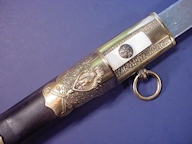
The skinning knife fitted in scabbard
|
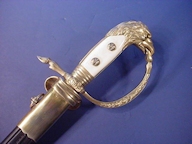
The reverse side
|
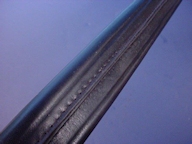
The stitching of the scabbard
|

The boot
|
|
|
Deluxe Hunting Cutlass Attributed to the Kaiser’s Guard Regiment—Das Regiment der Gardes du Corps (Item ANTWEP 2-29; GDUCORP 1-9; HUNT 8-9)
|
| DESCRIPTION: Here is a breathtaking example of a royal hunting weapon of the Prussian nobility. Unlike the much smaller examples that have a dog or a boar motif pommel, this one features a bold and handsome Prussian eagle as its crowning feature. All the metal parts of this piece are heavily gold plated. The grip of the weapon is crafted in white bone, as is the grip of the skinning knife. The eagle head looks a lot like the eagle motif on a Gardes du Corps helmet and we feel we can ascribe this wonderful weapon to that regiment. This, of course, was the famed regiment whose function was to be the personal guard to the German Kaisers of the Prussian Hohenzollern dynasty. Further evidence of this can be seen on the clamshell guard where you can see an enameled plate with the symbol of the Gardes du Corps on it surrounded by a hunting horn, oak leaves, and acorns, and this is surmounted with the Prussian crown of the empire.
The crown at this time—mid 1700s to the late 1800s—was only seen on royal articles: such things were closely regulated. This is no peasant piece. It is 100-percent either royal or at least owned by the officers of the elite GDC. The bone grip of the main cutlass and on the skinning knife are decorative roundels that are described as Sonnenrad (sun wheels). This was known to be another symbol of the various guard regiments. This weapon measures 29 inches in its scabbard with a blade measuring 21 inches long. The blade is quite beautiful employing various etched hunting scenes with stags, boars, game birds, rabbit, wolf, hunting horn, and many wonderful floral designs. On the backside of the blade (about 8 inches of it) are in much-used shape as these Hirschfänger were not only beauty contest participants, but were actually used on the royal hunting sport. That usage does not merge into but a tiny bit of the floral etching. All in all, the entire piece, except for this blade usage that really does not at all detract from it, is in practically mint condition and is nothing short of prodigiously spectacular!
PRICE: SOLD
Germania International will not ship any item that contains any animal parts to any country where such items are prohibited!
|
|
| 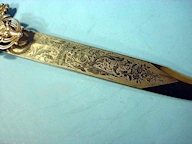
|
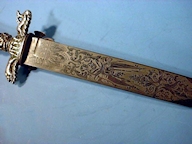
|
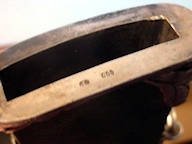
Note the silver marks
|
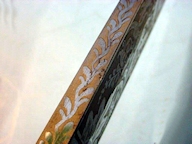
The top edge of the blade
|
|
|
Ausstelung Hirschfänger (Exhibition Hunting Knife) (Item ANTWEP 2-30; HUNT 8-10)
|
| DESCRIPTION: This is without a single doubt the most fantastic edged weapon we have ever laid eyes on. It is seen here just dripping with Germanic Hochkunst (high art,) although it looks like something that would have been the property of a king or emperor (although it just might have eventually been such!). It started life as a special exhibit item from a maker in Solingen, Germany. The fact that it has no maker’s mark is indicative of that !!! Once a year artisans in the “city of blades” submitted the absolute greatest and finest of their work to be exhibited in intensive competition with the hope of winning first prize. This contest was open to all the various companies that manufactured edged weapons and only their handmade items were allowed to be exhibited. Also, the individual nonaligned knife makers and blacksmiths that specialized in bladed objects also were encouraged to exhibit their masterpieces and it was usually those artists who would win first place. Undoubtedly, this particular masterwork would easily have been the victor. If anyone were to visit the Deutsches Klingenmuseum near Solingen they would actually be hard pressed to see an example of a grandiose hunting knife that could even start to rival this one that we offer here. This knife is definitely unique (one of a kind) and for sure the product of an individual maker and surely the only one in the entire world and it’s a pretty safe bet that you surely see here the winning entry. In all our long experience in this field we have never encountered anything as stunningly beautiful as this piece. It is also the epitome of Germanic beauty with very extensive high-relief oak leaves and acorns all individually joined to the scabbard in pure 800 silver. The 800 silver mark can be seen twice on the parts along with the half moon and crown. These were the mandatory marks that are required to be used by a maker of items containing silver. This was a regulation of the government minting office for silversmiths. The blade on this piece is interestingly Bowie shaped giving credence perhaps to the German infatuation with the romantic weapons of the American West. The blade is also a treasure in itself with heavily engraved floral and armament motif—knights, helmet, pole arms, swords, cannon, flags, lancers, armor, rifles, bayonets, etc. The floral sections are particularly gorgeous! The clamshell guard bears a stag’s head entwined with hunter’s horns with openwork. The crossguard features a running stag on the left with a boar running on the right. The upper guard support has a hunter thrusting his spear into a wild boar that is beset by hunting hounds. The pommel shows another boar being attacked by hunting dogs. The grip is formed with a stag’s horn. The back of the blade has more oak-leaf trim. There is no signature on the piece and that is the point that proves the exhibition aspect of this magnificent knife. The exhibition rule was that items put up for exhibition would never be marked with maker signatures so that the exhibition judges would not be biased toward any participant regardless if it were a company or individual. The knife is big–a little over 20 inches in its scabbard and the blade measures 13 inches. The scabbard is made of leather under all that silver and it is in a beautiful green hue with no seam showing. We will only be judged repetitive if we say again that this is probably and possibly the most incredibly matchless item we have ever offered, and certainly the most beautiful!
PRICE: SOLD
|
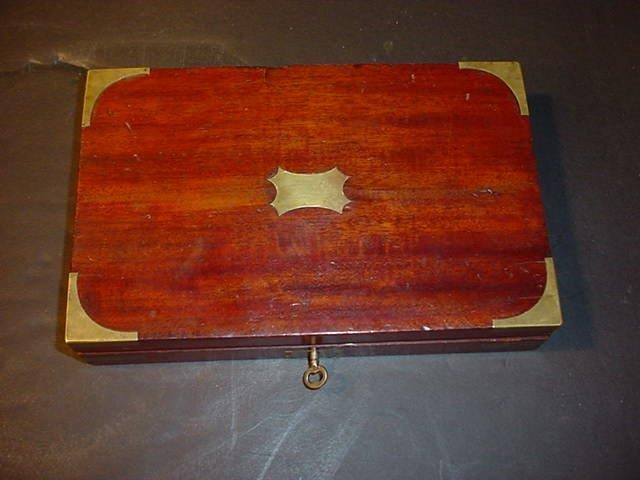 |
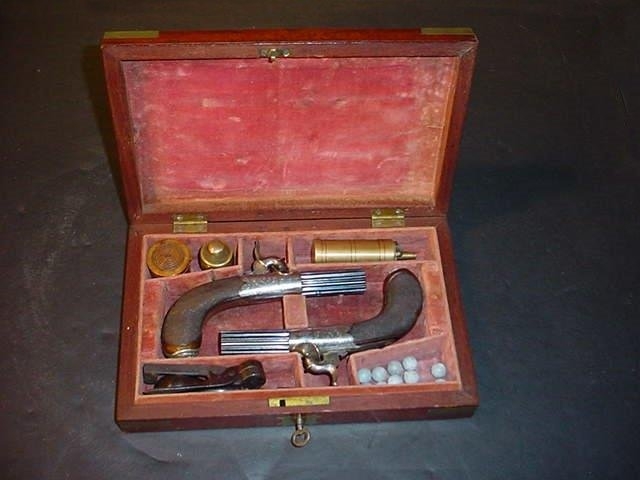 |
| 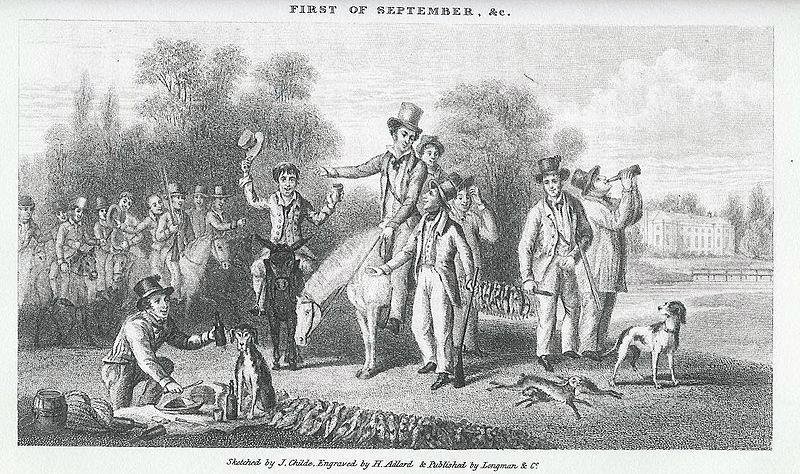
Peter Hawker and Joe Manton at a shooters' convention in the good old days
|
| 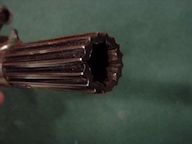
|

|
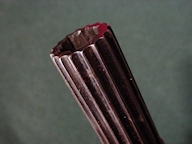
|
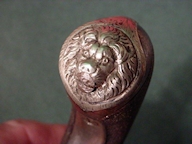
|
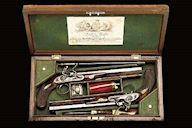
Another set of pistols by J. Manton sold at a Christie's Auction
|
Wonderful Brace of Percussion Pistols Cased with all Appropriate Tools (Item ANTWEP 2-32)
|
DESCRIPTION: Here are a beautiful brace of gentleman’s pistols in great condition in its original case with all the appropriate accompaniments contained. These are also often called “muff pistols.” They have folding triggers that drop from the underframe when the hammer is pulled back. They have screw-off Denzien-style BBL with walnut checkered grips. The barrels are very unusual with beautiful stylized fluting; wonderful tight engraving attends the décor of the pistols that were undoubtedly very expensive in their day and age. The butt caps bear the face of an unfriendly lion in silver. The side plates have the name “Manton” on one side and “London” on the other. The case that contains the weapons is a very lovely item on its own; possibly of cherry wood with a brass plate for the possibility of initials or name to be applied. The inside of the cover has a fine velvet-padded cloth and the color of the compartments closely matches its crimson hue. No degree of the talent of the gunsmith, Joseph Manton, was wasted on this magnificent example of the early weapons industry at its finest. Joseph Manton (1766-1835) was an inventor and highly accomplished gunsmith. He was also a sportsman who innovated sport shooting. He certainly improved the quality of weapons and, by the way, actually paved the way to the modern artillery shell. He was also a sports shooter in his own way and was a friend of Peter Hawker, who was a celebrated artist, author, and sportsmen who was accounted one of the great shots of the 19th century. Hawker served with the 14th Light Dragoons under the Duke of Wellington during the Peninsular War. He led his squadron brilliantly during the Battle of Douro (May 6, 1808) and as a result of his bravery and diligence he was made a lieutenant colonel of the militia in 1821 and ultimately became deputy lieutenant for the country. Hawker was a firm and loyal friend of Joseph Manton and he helped design and used many of Manton’s guns and took an active interest in their design. He was very inventive and created many important innovations in the arms industry. Between Hawker and Manton many revolutionary new designs were advanced in firearms and other early 19th-century weaponry. This set of pistols no doubt is the mutual idea and design of both highly innovative technicians in their romantic age. They certainly are a work of art and weapons mastery.
PRICE: $8,500.00 |
|
|
|
|
|
|

Germania |
|
|
|
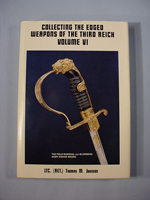 Tom Johnson's Book No. 6
Tom Johnson's Book No. 6 |
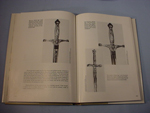 Our sword
Our sword |
|
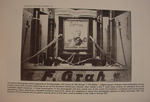 Showroom window 1937 - note our
Showroom window 1937 - note our
sword second from right |
|
Massive Motif Showroom Sword by Eickhorn (Item ANTWEP 2-33; ART 16-15) |
DESCRIPTION: This wonderful display (austellung) sword is featured on pages 162 and 163 of Thomas Johnson’s volume 6 of his Collecting the Edged Weapons of the Third Reich. Take notice of the interesting wordology in his description that is on page 161. He beautifully praises the architectural realizations and supreme artistic aplomb of the Third Reich while entering comments dear to the hearts of Germanophiles about the accomplishments of Richard Wagener and Arno Brecker. He quotes Reichsfuhrer SS Heinrich Himmler who said “May the spirit of the most ancient past be the spirit of the future” and Mr. Johnson then observes that there are countless specimens of this spirit throughout the artistic expression of the period and the firm of Carl Eickhorn chose to contribute to that trend in the form of six famous swords, all with allegorical scenes different but all of them conforming to that spirit. They were made for display to demonstrate the proficiency and excellence of Eickhorn’s designers and the steel craftsmanship of its art staff and sword smiths. These swords were never intended for sale to the public. They were only for visual presentation in the factory headquarters. They were a source of intense pride in the art of ‘klingenmachen” in the city of the swords Solingen. From time to time the display swords were loaned to dealerships in Solingen who would feature them in their shop windows for a limited amount of time but they were never sold. The other sword that is referred to as this one is as the “Middle Age Motif “and it is also shown in Mr. Johnson’s book on pages 103, 164 and 165. Both swords are described with this Middle Age motif. There were six display swords. The others were billed as the “Old Timers” and two of them are shown on pages 166 through 172; we believe the one we have procured is by far the nicest of them all with its allegorical motifs. Tom says it reminds him of the two handed swords of the Middle Ages -- this one we have is indeed massive and the largest of the six Eickhorn display swords. Tom’s description couldn’t be better so I do hope he will not object that we use it here with many thanks to him for being there in Germany when we bought it and advising us that this was a great purchase.
“The hilt is made out of a one piece cast silvered bronze. Chiseled in such a way as to represent strong allegorical symbols referring to the ancient Greek Divinities but also to the pagan life and death imagery. The pommel cap also has the remnants of a crown, but it was highly transformed so as to make the break with the past and yet remind the onlooker of the power residing in the symbolism attached to the crown. The highly polished steel blade has a large fuller in its center all the way down to the tip and bears like all the other showroom swords the company’s motto."
The measurements of this huge sword is as follows: 111. OCM (43.70 inches) length of the blade 90 OCM 35.43 inches. The width of the blade (ricasso) 3.9 cm (1.54 inches). The Eickhorn squirrel holding sword is the type used during the Third Reich Period. The ends of the beautiful cross guard has rams heads possibly representing Jason and the Golden Fleece. The grimacing skull wears the leaf motif wreath as worn by the Imperial Roman Caesars. On the other side is a figure that probably depicts with its feminine form one of the norms of Grecian Saga. The female figures in the center of the grip represent undoubtedly Germania holding the sword of war on one side and the olive branch of peace on the other. In high relief on the blade are letters in huge form that spell out – Original Eickhorn Blanke Waffen – which means “Original Eickhorn Edged Weapons.” This huge sword is without a doubt one of the most beautiful pieces we have ever offered and certainly would be the center piece and dazzling star of any WWII blade collection and the fact that is an important, published item in the Johnson books makes it not only a noted item but completely unique and spectacular.
PRICE: SOLD
|
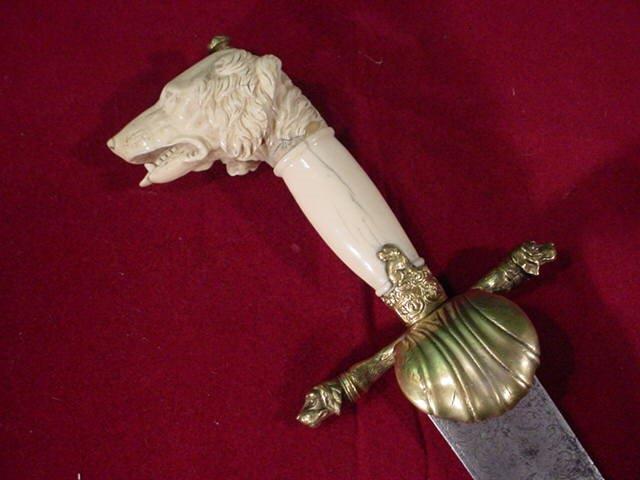 |
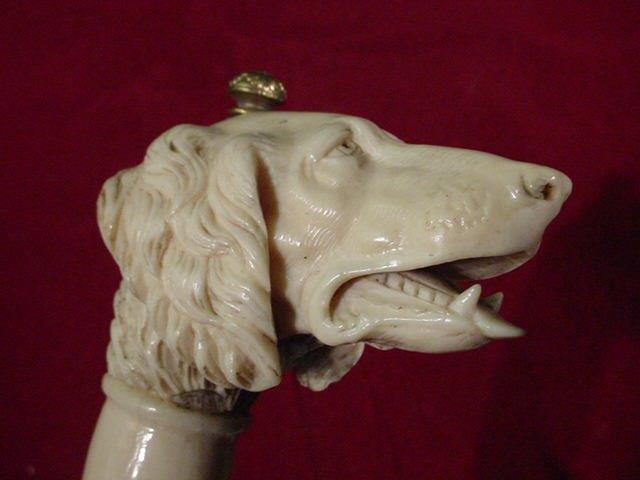 |
Magnificent Hunting Sword of the 18th Century (Item ANTWEP 2-34; HUNT 8-13)
|
DESCRIPTION: This is a very unusual hunting sword attributed to royalty or, at least, to a very wealthy member of the landed gentry. The piece is German and from the looks of the blade it seems to be from at least the early 1700s, or possibly even in the mid-to-late 1600s. The most unusual thing about it is the fantastically detailed head of a hunting dog carved into the bone finial or pommel. The swordsmith who carved this magnificent hound had to be an absolute master of the craft. The eyes, the nostrils, the great ears, and especially the teeth and tongue are prodigiously lifelike. The hair of the dog and his ears are especially noted: The breed very well could be the famed large Munsterlander that was used often in medieval hunts. The grip is also carved in fine white bone--indeed rare--and were purchased only by the wealthy. Between the bottom of the grip and the crossguard and clamshell fixture is a brass ring that has a hunting dog perceived as sitting on his haunches. Additionally, at each end of the crossguard are the heads of hunting hounds and the blade scenes are depictions of the hunt with dogs. So, with a bit of extrapolation license, I will say this is undoubtedly a Jagdschwert (hunting sword) whose main purpose was to be used in the hunt for Wildschwein (boar) and in a boar hunt it was usual to hunt while on foot employing a boar spear and a side weapon. This was a most dangerous sport as a boar is a formidable beast and have been known to attack and kill many stalwart hunters with their razor-sharp tusks. So, the side weapon had to be a stout piece capable of slaying quickly this often huge and fiercely angry beast. The blade on the weapon offered here is quite thick and heavy and reasonably capable of the task as long as the man who wields it is strong and maneuvers well. Possibly it is the most dangerous of all sports and not for the feeble. The blade as we indicated is engraved with hunting scenes namely with hounds hunting boar and chasing deer. The sword is almost 30 inches long and the blade is 24-1/2 inches long. Here is an antique weapon worthy of being in the hunting museum in Munich—it is that fine!, and is also historically important.
PRICE: $18,500.00; this is a museum piece extraordinaire!
Germania International will not ship any item that contains any animal parts to any country where such items are prohibited!
This antique weapon is well over 300 years old. |
Contact Us
Please refer to item designator in parentheses in all correspondence.
Please E-mail for any additional information you may need.
If you prefer, contact 'Germania' at PO Box 68, Lakemont, GA 30552
or call at 706.782.1668.
Please! do not call during the wee hours of the morning. The best time for calling us is between 10 am and 12 noon and between 9 and 11 pm eastern time.
|

![]()
